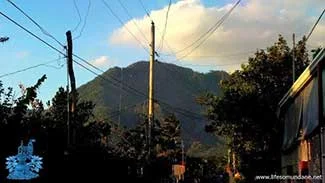The Fierce Battle for the Control of Cuenca and Mount Makulot in 1945
After the landing of Allied forces on the shores of Nasugbu on the last day of January 1945, among their immediate objectives was the clearing of the so-called “Lipa Corridor” of Japanese troops. A mobility corridor is an area through which troops can be channeled due to terrain or land restrictions1. This Lipa Corridor was an area from the Bay of Batangas all the way to the southwestern shores of Laguna de Bay2.
On 4 March 1945, troops of the United States Army’s 158th Infantry moved out from Nasugbu to clear the shores of Balayan and Batangas Bays, meeting “negligible opposition” along the way. By the 11th, the combat group had reached the town of Batangas. Just five days later, the whole of the Calumpang Peninsula had been cleared.
Other elements of the combat group, meanwhile, started to face stiff Japanese opposition as they made their way northeast along Route 417. This is the same road that branches out from the Taal-Batangas road in the present day at Santa Teresita and goes to Lipa.
The so-called “Fuji Force,” named after its commander Colonel Masatoshi Fujishige, had 1,250 men and was well-equipped. Fujishige’s defenses were concentrated in the town of Cuenca and on Mount Makulot, with small pockets of troops scattered along Route 417.
By the 23rd of March, the 158th Infantry had cleared the fringe Fuji Force defenses leading to Cuenca. The main Japanese defenses on Mt. Makulot, however, remained intact and seemingly impregnable. That same day, the 158th had to disengage in preparation for operations in the Bicol Peninsula. It was replaced by the 11th Airborne Division.
The latter was given orders by its commander, General Oscar Griswold, “to complete the reduction of Japanese defenses at Mt. Macolod, seize Lipa, and clear Route 19, the main road through the Lipa Corridor, for five miles north of Lipa.” Clearing the rest of the corridor all the way from the town of Lipa to Tanauan and Santo Tomas, in fact, turned out to be far easier than the “reduction of Macolod,” as the Americans referred to the mountain.
The task of seizing Makulot fell to the 187th InfantrThe Japanese Army on its way to Manila. Image credit: Wikipedia.y. The combat group began its offensive on 24 March. It was not until the first of April that the group managed to encircle the foot of the mountain.
G. P. Cox described the operation:
“F and G Companies of the 187th began house-to-house fighting, but were met by massive machine-gun fire. The enemy was dug in too far underground. Napalm3 strikes were brought in which enabled the 1st of the 187th to go around to the north of Dita4 and the 2nd held its position near the town. This was 27 March 1945. Both units made a frontal assault into the Macolod area the following day. The flamethrowers were used on the enemy bunkers and E and G Companies made it to the top of the crest. Their M-1 fire took out snipers and more advancement was made, but the Japanese returned with mortar fire and a withdrawal was necessary. The enemy came at them throughout the night and following morning with banzai attacks. This was a fierce and bloody battle, especially for men who have never been sent into reserve5.”
The drive to take Mt. Makulot tapered down somewhat in the last days of March through to the first days of April as some elements of the 187th had to be pulled out to concentrate on the liberation of Lipa. Because Japanese defenders had withdrawn to Mt. Malepunyo, this town was officially taken on 29 March, crucially with it the airfield from which the Japanese had launched countless raids.
With Lipa secured, the bulk of the 187th could dedicate all its energies to the reduction of the last firm Japanese defensive stand at Mt. Makulot, where they were isolated, after all. When fighting resumed, it was of the sort that some World War II chroniclers referred to as among the fiercest and bloodiest ever fought in the Southwest Pacific Theater of War7.
Cox again described some of the action, “The battles around Macolod continued making this one of the bloodiest battles the 187th ever fought. The regiment received massive downpours of artillery, but when the troopers discovered that the guns were all grouped together, they were eradicated. The 187th was exhausted by this point and diminished even further by casualties and wounded, but rest was not on the schedule8.”
Finally, by 21 April, the 187th had overcome all Japanese resistance at Mt. Makulot. The operation was started on 19 March by the 188th Infantry, had to be set aside as the Allied forces concentrated on the liberation of Lipa, Tanauan, Santo Tomas and the rest of the so-called Lipa Corridor. The Fuji Force was isolated, exhausted, short of ammunitions and ultimately had no recourse but to stare defeat in the eye.
2 Along with many other details of this articles, from “US Army in World War II: The War in the Pacific, Triumph in the Philippines,” by Robert Ross Smith, online at Ibiblio.org.
3 “Napalm” is a flammable liquid used in warfare. Wikipedia.
4 Dita is one of the barangays or villages of the town of Cuenca, Batangas.
5 “Mount Macolod, Part I,” by GP Cox, online at the Pacific Paratrooper.
6 The P-47 was a fighter-bomber which could also be used in ground attacks. Wikipedia.
7 The Southwest Pacific Theater of War in World War II extended from the South Pacific islands to the Dutch East Indies, Australia, New Guinea, Borneo and the Philippines. Wikipedia.
8 “Mount Macolod, Part II,” by GP Cox, online at the Pacific Paratrooper.


